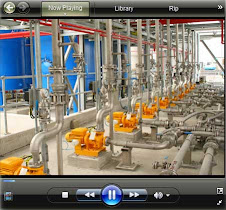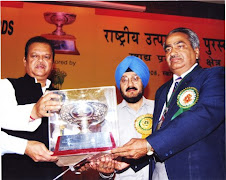ISO Consultants India Delhi ISO Certificate India ISO 90012008 Mumbai noida Bangalore
Wednesday, December 24, 2008
Steps to Implementation, Maintenance Audits & Training
1. On-site training of our client’s staff to the requirements and expectations of the project. This includes a critical course on the introduction to the standard.
2. Next comes information gathering from the relevant departments to begin charting the company's internal interactions and determination of relevant existing documentation and procedures.
3. Creating a customized corporate Quality Manual that preserves the unique activities of each company is one of ISOmatrix's greatest strengths. Quality Manuals need to reflect the things that make your company special and ISOmatrix focuses on creating systems that take full advantage of our client company's competitive advantages from small Mom & Pops to Multi-facility, multi-nationals.
4. Level 2 - procedures are the next level of documentation that ISOmatrix can prepare. There are procedures required by specific standards and ISOmatrix focuses on creating a perfect merge of each unique business with the written requirments of the standard with two goals in mind:
o Meeting the requirements for certification
o Maintaining a simplified document path as a useful system component for each unique business
5. Level 3 - Work Instructions if requested. Once again, training on each Level is a critically important part of a successful implementation, so ISOmatrix performs on-site training to get each project off to the best possible result.
6. Based on Client request, ISOmatrix can stay involved through the deployment phase or hand it over to management.
How Will ISO 9001:2008 Relate To The Needs Of Specific Business Sectors?
ISO 9001:2008 remains compatible with existing management systems standards for specific business sectors like ISO/TS 16949, AS 9000/EN 9100 and TL 9000.
Users of a specific sector scheme should refer to the organization that is responsible for that sector scheme, e.g. for:
- ISO/TS 16 949 refer to the IATF,
- TL 9000 refer to the QuEST Forum
- For AS 9000/EN 9100 refer to the IAQG
How Does The New ISO 9001 Standard Affect Existing ISO 9001 Quality Management Systems?
ISO/TC 176 was careful in not making change for change sake. The changes that have been incorporated into this edition of the ISO 9001 standard include changes that should lead to a better understanding across a broader range of product types, including service organizations; use of deliberate wording to minimize the potential for incorrect user interpretation; and reflect nuances of similar word concepts. Lastly, some of the changes to specific clauses were made based on the 2004 International User Feedback Survey. This survey was conducted after the publication of ISO 9001:2000 and had invited respondents to identify areas they most wanted to see improved.
What Is The ISO 9001: 2008 Standard?
ISO 9001:2008 is a standard that provides a generic set of requirements for organizations wishing to develop a quality management system (QMS). The ISO 9001:2008 standard focuses on improving an organizations business processes. It does not specify any requirements for product or service quality. Customers typically set product and service quality requirements. However, the expectation is that an organization with an effective ISO 9001 based QMS will indeed improve its ability to meet customer, statutory and regulatory requirements.
What are the workshop contents.
Introduction of the changes and transition to ISO 9001:2008
• Assessing your organisations current perception of ISO 9001
• Maximising the opportunity that change presents
• Creating a financial balance sheet of costs and benefits
• Introduction of tools for bringing about change in engagement and perception
• Creating a personal action plan for your organisation
Integrated Management Systems Course for TS 16949:2002,OHSAS 18001:2007,ISO 14001:2004 and ISO 9001:2008
ISO 9001:2008
The November 2008 issue of Quality Digest magazine said ISO 9001:2008 “clarifies requirements in outsourcing, document control, and customer relations ... Many of the changes are designed to bring about better compatibility between ISO 9001 and the ISO 14001 environmental management systems standard.”
Why do I need to be certified to do this?
Steps for Implementing Continuous Improvement
This is important because companies that do not continue to improve are soon overtaken by the competition.
Implementing an ISO 9001:2008 is a win-win proposition!
The ISO 9001 standard is an international model for quality management systems.
ISO 9001:2008 is designed around common business practices which are influenced by the size and structure of the company, their established objectives, the products and services they provide, and the processes used to meet customer requirements.
The intent of the standard is to provide guidelines for developing, implementing and improving a quality management system to enhance customer satisfaction and to consistently deliver quality products and services. The continual improvement of the company's overall performance should be a permanent objective.
Debate on the effectiveness of ISO 9000
The debate on the effectiveness of ISO 9000 commonly centers on the following questions:
- Are the quality principles in ISO 9001:2000 of value? (Note that the version date is important: in the 2000 version ISO attempted to address many concerns and criticisms of ISO 9000:1994).
- Does it help to implement an ISO 9001:2000 compliant quality management system?
- Does it help to obtain ISO 9001:2000 certification?
Description of the ISO 9001:2008
Duration
This course is taught as a one-day class. For coverage of key implementation activities, documentation structure, audit preparation, and the registration process, attend our two-day Implementing ISO 9001:2008 course.
what are the new requirements of the new standard?
- Statutory requirements are given scale as any other legal or customer's requirements.
- The statutory requirements are including the suppliers as well.
- A purchased process is just like any other product that the organization purchased. If it's affecting the product it must be under the quality system.
- You may include two quality processes in one document and split one process to two documents.
- The management representative must be a member of the management.
- A requirement to ensure that trainings are suitable for the product in advance and not to check if the training was effective after it was taken.
- Information system in now officially considered as a substructure.
- Parameters such as humidity, noise and temperatures, concerning the employees' health are considered as working environment.
- Measuring is considered as one of the activities of product realization.
- The product must be identifying not only on the shelves but also throughout the realization process.
- The management is now responsible for preventive and corrective actions regarding nonconformities that were discovered suring audit.
ISO 9001:2008 Quality system Documentation Description
Lectures by experienced instructors, along with practical team exercises, will help you gain the necessary skills to evaluate and prepare quality manuals, procedures, instructions, and forms.
Why is the new version an amendment and not a revision?
The committee kept changes to clarifications deemed necessary as a result of the comments received and to increase compatibility with ISO 14001 and the soon-to-be-revised ISO 9004. 'Comments rejected because they call for a major revision have been archived for review at the next full revision,' explains Chris.
Internal Auditor Training for ISO 9001:2008 Objectives.
- Internal Quality Systems Assessment? Discuss the elements of a quality system, interpretation of the requirements of ISO 9000, and what third-party assessment agencies look for.
- The Three Audit Phases-Planning, execution, and follow-up are examined closely using concepts detailed in ISO 19011.
- Planning and Auditing-How to prepare for an audit and how to manage your resources effectively.
- Conducting the Audit-How to collect objective evidence and document observations, including techniques for effective questioning and listening.
How is the Standard changed ?
The good news is that the 2000 version of the standard promises benefits that will apply equally to small firms as to large organisations. These include the following :
- Written in clear language; simple to use and less bureaucratic
- Applicable to all sizes of organisation and all product sectors - including service
- More emphasis on 'the processes' of a business
- Ability to reduce the scope, according to the type of organisation
- Compatible with related standards, such as ISO 14001 (Environmental)
- Provides a pathway to continual improvement
Why are customers embracing ISO 9001: 2008?
ISO 9001:2000 Documentation Requirements
(1) Quality Manual
The Quality Manual describes the overall quality management system of the company. Writing the Quality Manual is usually the starting point of developing the ISO 9001 documentation. ISO 9001:2000 requires the Quality Manual in section 4.2.2
2) Six Quality Procedures
The Quality Procedures describe in relatively general terms the overall process flow, its interaction with related processes, as well as the distribution of authorities and responsibilities. Writing the Quality Procedures is usually regarded the most difficult part of developing the ISO 9001 documentation. ISO 9001:2000 requires the Quality Procedures in the following sections:
- ISO 9001:2000 section 4.2.3 (Control of Documents)
- ISO 9001:2000 section 4.2.4 (Control of Records)
- ISO 9001:2000 section 8.2.2 (Internal Audit)
- ISO 9001:2000 section 8.3 (Control of Nonconforming Product)
- ISO 9001:2000 section 8.5.2 (Corrective Action)
- ISO 9001:2000 section 8.5.3 (Preventive Action)
(3)Quality Policy
The Quality Policy is the top-level policy directive regarding quality and customer satisfaction. It is usually a short one- to two-paragraph statement. ISO 9001:2000 requires the Quality Policy in section 5.3.
(4) Quality Objectives
Quality Objectives are designed to support the Quality Policy. They are specific and measurable goals. As the goals are met, new goals are set. ISO 9001:2000 requires Quality Objectives in section 5.4.1.
(5) Process Flowchart
ISO 9001 requires "a description of the interaction between the processes of the quality management system". Though this description can be in an form, a flowchart is a very appropriate format. ISO 9001:2000 requires the "description" in section 4.2.2.
Friday, December 19, 2008
Validity of certifications to ISO 9001:2000 .
What are the main changes?
The main changes are the following:
- Reinforcement of control over outsourced processes that affect product conformity to requirements
- Management representative has to be a member of the certified organisation and not an external individual
- Competence is much more a key issue in the new standard as it specifies that the competence of personnel affecting the performance of conformity to product requirements must be controlled by the organization.
- Additional guidance to explain the different methods on measuring and monitoring customer satisfaction
- Concerning the internal audits, the management of the audited units must ensure that necessary corrections and corrective actions are taken
- Clarification that information systems are included as a part of the company’s infrastructure, and therefore the management system.
The Impact on the ISO 9001:2000 Assessment.
Like its predecessor, ISO 9001:2000 is really a series of three interrelated standards. Each has a different function: ISO 9000 deals with fundamentals and vocabulary; ISO 9001, the heart of the new revision, states the requirements for the new system; ISO 9004 provides guidance for implementation, and fleshes out ISO 9001.
What are the changes in ISO 9000:2008?
What is this all about?
Who should attend?
Learning Objectives
- Understand ISO 9000 Quality Management Principles
- Learn the requirements and intent of the ISO 9001:2008 standard
- Know how to apply the ISO 9001:2008 requirements
Breathe new life into your Quality Management System!
Your organization will achieve ISO 9001:2008 registration quickly, cost effectively and efficiently.
We will document your Quality Manual, Procedures, set up all the required records and forms for you.
- Executive Overview
- Support you need for success
- Implementation training
- Techniques that ensure audits are Value-Added
- Sector specific solutions for Software, Hardware, Services, and Manufacturing industries
- Registrar selection
ISO 9001:2008 Vs ISO 9001:2000 new ISO 9000 Requirments
In order to celebrate this event in a way that only quality managers know how, we prepared here a comparison article between the ISO 9001:2000 and the new born ISO 9001:2008. We also included our comments regarding our experience and our perspective of things. At the end of it we will summon the new requirements freo the ISO 9001:2008 standard.
There will NOT likely be any significant changes to ISO 9001:2000 when it is revised in either 2008 or 2009. Here are some related facts that support
The ISO Review Process requires a review of each standard at least every five years. Their commitment to continual improvement involves constant review of each standard, which for ISO 9001 has been conducted through surveys, focus groups and one-on-one discussions. Suggestions for changes have come from companies worldwide, ranging from international corporations to family businesses.
ISO 9001:2008 Certification/Registration
ISO 9001:2008 released finally.
ISO 9001:2008, Quality management system – Requirements, is the fourth edition of the standard first published in 1987 and which has become the global benchmark for providing assurance about the ability to satisfy quality requirements and to enhance customer satisfaction in supplier-customer relationships.
What is ISO 9001:2008 Quality Management System -Requirments .
What is an ISO 9001 Compliant Quality System?
What are the Principles of ISO 9000.
1) Customer Focused Organization
Take care of the customer first. Companies that focus their energies on customers outperform those that are inwardly focused. Customers don't reward their suppliers for simply following a procedure. You depend on your customers. You should understand their requirements and expectations and work to exceed them.
2) Leadership
Top management should be leaders. Continual improvement and increased customer satisfaction are attainable when led by top management. Leaders provide direction and make sure everyone is steering the same course.
3) Involvement of people
People make quality a reality. The folks that do the work must know what their customer expects. And, everyone works toward the same goal ... the customer's satisfaction.
4) Process Approach
Plan and setup work the way it naturally flows. When operations and departments work together toward the same goals there is a structure for managing and improving. The whole must be greater than the sum of its parts.
5) System Approach to Management
A company will be more effective if they manage a system of interacting processes. Managing each process as stand alone operations causes conflicts among processes because they work toward individual goals and not what the customer wants.
6) Continual Improvement
Being world class isn't achieved by accepting the status quo. Small improvements made on an ongoing basis makes world class a reality.
7) Factual Approach to Decision Making
Decisions about change are based on empirical information. Wishing something better doesn't work. You have heard it before and it's worth repeating "If you don't measure it, you can't manage it".
8) Mutually Beneficial Supplier Relationships
Make suppliers partners in your efforts and theirs. You depend on suppliers so you should work toward win-win outcomes. They are the experts in their chosen area and product. Everybody prospers.
How to apply for accreditation.
- Submit application form, required documents and fee
- Pre-assessment: Initial review of application and requests for additional information or clarification
On-site Assessment
- Assessors identify any areas or items that do not meet the specific program requirements and suggest corrective action
- Additional audits and follow-up visits as set out in accreditation requirements
Approval
- Report prepared including recommendation about whether or not to grant accreditation
- Review by the Standards Council of Canada
- Final decision
Accreditation
- Upon approval, accreditation and trademark license agreements are signed
- Notice of accreditation posted to Standards Council of Canada website
What are the documents we need to send?
- Quality Policy Statements
- Quality Objectives
- Quality Manual
- Quality Procedures
- Standard Work Instructions / Standard Work Methods (if any)
- Work Quality Plans (if any)
- Process Flow Charts (if any)
- Material Quality Plans (if any)
- Inspection and test Plan (if any)
- QA / QC plans (if any)
- Standard Forms
Implementation of accredited certification to ISO 9001: 2008
What does this mean for you, if you are already ISO 9001:2000 certified?
ISO 9001:2008 has been Published
ISO 9001:2008 contains no new requirements compared to the previous 2000 edition, which it replaces. It merely provides clarifications to the existing requirements of ISO 9001:2000 and introduces minor changes intended to improve consistency with the environmental management system standard, ISO 14001:2004.
Users of ISO 9001:2000 will have up to two years to upgrade their systems to ISO 9001:2008
ISO 9001 is the world’s most established quality framework.
It is used by around 897,000 organizations in 170 countries worldwide, and sets the standard not only for quality management systems, but management systems in general.
It helps all kinds of organizations to succeed through improved customer satisfaction, staff motivation and continual improvement.
ISO 9001:2008 Lead Auditor Over view
ISO 9001:2008 Transition Programme
Outline
- A look at the ISO 9001:2008 standard.
- An overview of the significant changes to the requirements of the standard.
- A discussion of the impact of these new requirements on clients’ systems and maintenance audits.
- A question and answer session to provide participants with interpretive information on how to approach the changes.
Objectives
Through lectures, discussions, and workshops, you will gain an understanding of:
- The underlying philosophy and the principles, concepts and requirements of the ISO 9001:2008 standard;
- How these may be applied within an organisation;
- The key differences between the revised series of standards and the 2000 and 2008 version;
- The implication of these differences.
ISO 9001:2008 Revision
Amendments are mainly to clarify existing requirements and to further align ISO 9001 with the requirements of ISO 14001:2004. Therefore for most companies the transition will require little effort to comply. There will be a 24 month period of grace for companies to make the transition from ISO 9001:2000 to ISO 9001:2008. 12 months after publication all new certifications and re-certifications will be carried out to ISO 9001:2008.The table below summaries changes of ISO 9001:2008. Click on the link below to find out about ISO's ISO 9001:2008 implementation plan.



